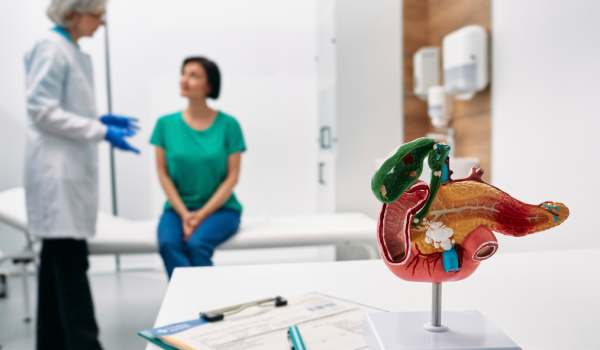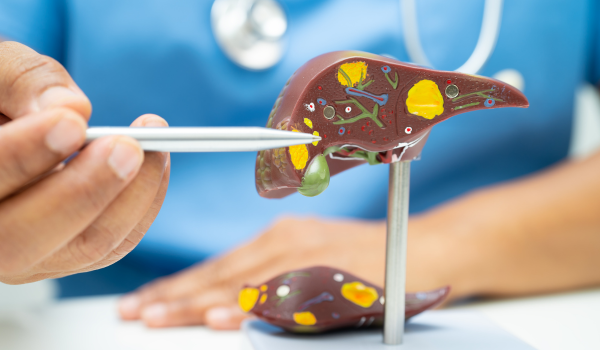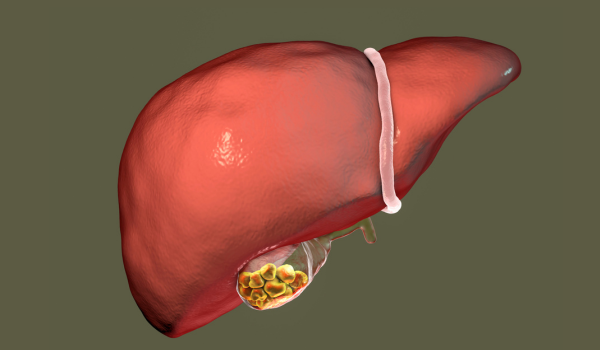Gallstones, also known as cholelithiasis, are hard, pebble-like deposits that can form in the gallbladder, a pear-shaped digestive organ beneath the liver. These deposits consist of minerals such as cholesterol and bilirubin that collect in bile—a digestive fluid produced in the liver and stored in the gallbladder.
Up to 15% of Americans may develop gallstones in their lifetime, with people assigned female at birth having a slightly higher risk. Gallstones can vary in size—from as small as a grain of rice to as large as a golf ball. While many gallstones don’t cause symptoms, complications may arise when larger stones form or when stones become lodged in the bile ducts.
Gallstones develop due to internal imbalances, such as excess cholesterol, bilirubin, or bile. In addition, certain health conditions and lifestyle habits can also raise the risk of gallstone formation.
Too Much Cholesterol
Bile is a yellow-green fluid made by the liver and stored in the gallbladder. It carries waste and cholesterol from the liver and releases it into the small intestine to aid digestion. Normally, bile salts dissolve cholesterol, but when there is too much cholesterol, it can crystallize and harden into stones.
Over time, these crystals may grow and become gallstones. Cholesterol gallstones are the most common type, accounting for about 80–90% of all cases.
Bilirubin Build-Up
The body constantly recycles blood cells, breaking down old red blood cells and producing bilirubin—a yellow pigment carried to the gallbladder through bile. Certain health conditions may cause the liver to make too much bilirubin, leading to the formation of pigment stones.
Pigment stones are darker, usually brown or red, and account for a small percentage of gallstone cases. People with blood disorders such as anemia are more likely to develop this type of stone.
Excess Bile
If the gallbladder does not empty properly, bile may build up inside, increasing the concentration and encouraging gallstone formation. Excess bile can contribute to both cholesterol and pigment stones.
Underlying conditions such as injuries, infections, nerve disorders, or intestinal diseases may affect gallbladder function and cause bile accumulation.
Are Gallstones Hereditary?
Genetics play an important role in gallstone development. Researchers have identified multiple genes associated with gallstones, many of which can be inherited. This is why having a family history of gallstones is considered a risk factor.
Some genes affect liver and pancreas function, raising the likelihood of gallbladder-related problems. Research shows that around one-third of gallstone cases occur within families, with both parents and siblings often sharing the condition.
Risk Factors
Several medical conditions and lifestyle factors can increase the risk of developing gallstones. These factors interfere with the gallbladder’s ability to process cholesterol or bilirubin, encouraging stone formation.
hormonal fluctuation
High estrogen levels in people assigned female at birth increase the risk of gallstones. Pregnancy, hormone replacement therapy, and certain birth control medications are common risk factors.
obesity
Excess body weight can impair liver and gallbladder function, making it harder to process bile properly and raising gallstone risk.
rapid weight loss
Losing weight too quickly, especially after bariatric surgery, can disrupt bile function. Studies show that 10–38% of people who undergo weight loss surgery develop gallstones.
liver and bile duct infections
Cirrhosis caused by hepatitis or alcohol use can scar the liver and disturb bile chemistry, leading to gallstones. Infections or inflammation of the bile ducts (cholangitis) also increase risk.
anemia
Blood disorders that cause red blood cells to break down prematurely, such as sickle cell anemia, are strongly linked to pigment gallstones.
diabetes mellitus
Diabetes increases blood sugar and impairs insulin function. People with diabetes have nearly a 50% higher risk of developing gallstones.
cholesterol issues
High levels of low-density lipoprotein (LDL, or “bad” cholesterol) in the blood raise gallstone risk.
metabolic syndrome
This condition includes a combination of obesity, high blood sugar, high blood pressure, low HDL cholesterol, and high triglycerides. People with metabolic syndrome are significantly more likely to develop gallstones.
intestinal diseases
Inflammatory bowel conditions such as Crohn’s disease can impair nutrient absorption and alter bile chemistry, contributing to gallstone formation.
lifestyle habits
Unhealthy diet, high carbohydrate and sugar intake, low fiber consumption, and lack of physical activity also raise the risk.
A Quick Review
Gallstones are small deposits that form in the gallbladder. While often harmless, they can cause symptoms when stones block bile ducts.
Excess cholesterol, bilirubin, or bile are the main causes of gallstones. Risk factors include hormonal changes, obesity, rapid weight loss, liver and bile duct infections, blood disorders, diabetes, and poor lifestyle habits.





